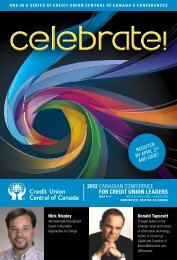A Practitioner’s Guide to Nudging
A Practitioner's Guide to Nudging - Credit Union Central of Canada
A Practitioner's Guide to Nudging - Credit Union Central of Canada
- No tags were found...
Create successful ePaper yourself
Turn your PDF publications into a flip-book with our unique Google optimized e-Paper software.
FIGURE 14<br />
MINDSPACE FRAMEWORK<br />
Messenger<br />
Incentives<br />
Norms<br />
Defaults<br />
Salience<br />
Priming<br />
Affect<br />
Commitments<br />
Ego<br />
We are heavily influenced by who communicates information<br />
Our responses <strong>to</strong> incentives are shaped by predictable mental shortcuts such as strongly<br />
avoiding losses<br />
We are strongly influenced by what others do<br />
We “go with the flow” of pre-set options<br />
Our attention is drawn <strong>to</strong> what is novel and seems relevant <strong>to</strong> us<br />
Our acts are often influenced by subconscious cues<br />
Our emotional associations can powerfully shape our actions<br />
We seek <strong>to</strong> be consistent with our public promises, and reciprocate acts<br />
We act in ways that make us feel better about ourselves<br />
Source: P. Dolan, M. Hallsworth, D. Halpern, D. King, and I. Vlaev, MINDSPACE: Influencing Behaviour Through Public<br />
Policy, Institute for Government, March 2, 2010, 8.<br />
presented <strong>to</strong> them and act in their best interest. Behavioural science suggests that policymakers<br />
can shape behaviour by focusing on the individual’s au<strong>to</strong>matic processes of<br />
judgment and influence. A behavioural approach recognizes that people can behave<br />
irrationally, are inconsistent in their choices, and are affected by their environment.<br />
Information and incentives can be effective instruments for shaping behaviour. However,<br />
behavioural science offers <strong>to</strong>ols that can enhance these instruments and offer alternative<br />
options when information and incentives are not appropriate.<br />
The Behavioural Insights Team has developed the MINDSPACE framework, which summarizes<br />
nine of the most robust behavioural influences (see Figure 14). These nine influences<br />
should be unders<strong>to</strong>od by policymakers and, if appropriate, used for policy.<br />
Validating Behavioural Interventions Using Randomized<br />
Control Trials<br />
A summary of Test, Learn, Adapt: Developing Public Policy with Randomised Controlled Trials (L. Haynes,<br />
O. Service, B. Goldacre, and D. Torgerson, UK Cabinet Office Behavioural Insights Team, June 2012, www.gov.<br />
uk/government/publications/test-learn-adapt-developing-public-policy-with-randomised-controlled-trials)<br />
Randomized control trials use control and test groups <strong>to</strong> evaluate interventions. Alternatively,<br />
one can implement an intervention and measure the results, but it is difficult <strong>to</strong><br />
evaluate whether it was the intervention that made the difference or another fac<strong>to</strong>r in the<br />
PAGE 27 SUMMARIES OF RELATED DOCUMENTS FILENE RESEARCH INSTITUTE



